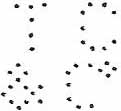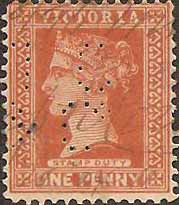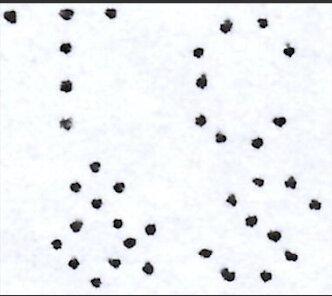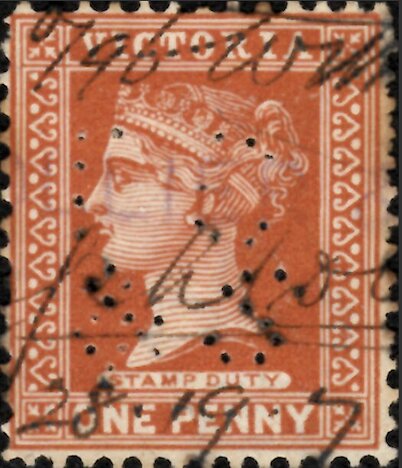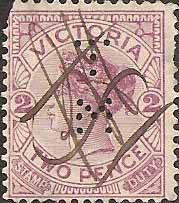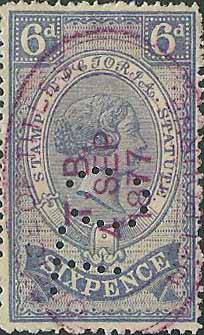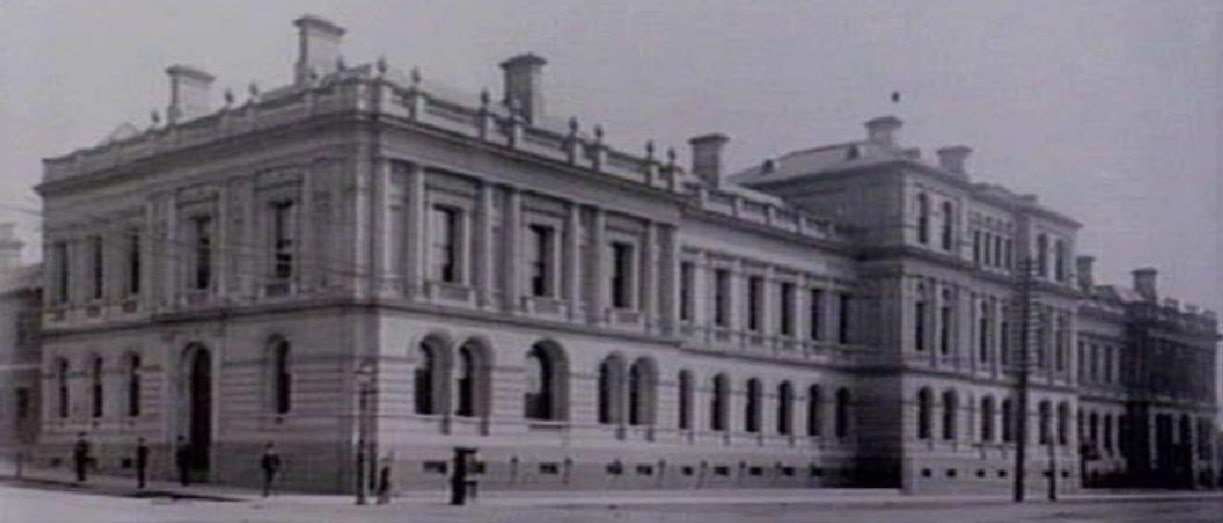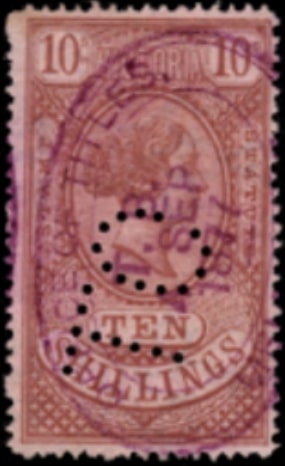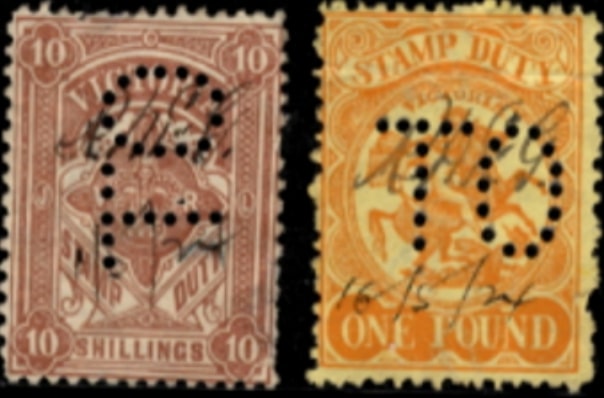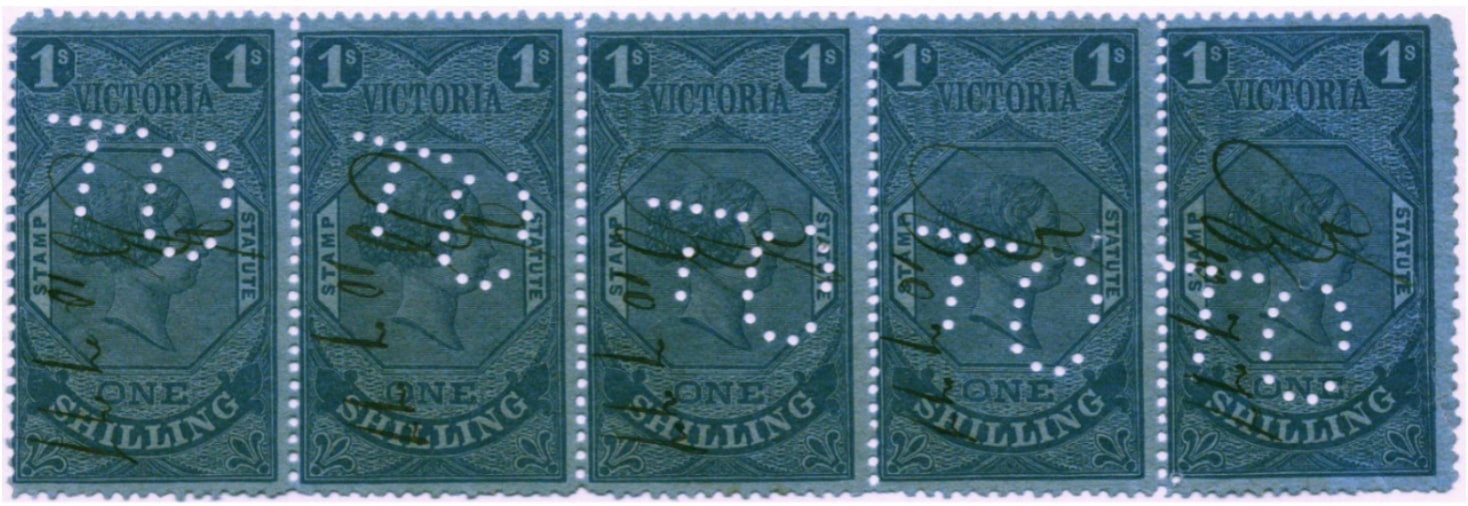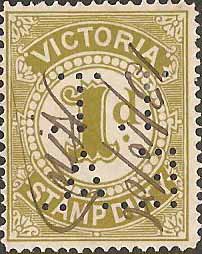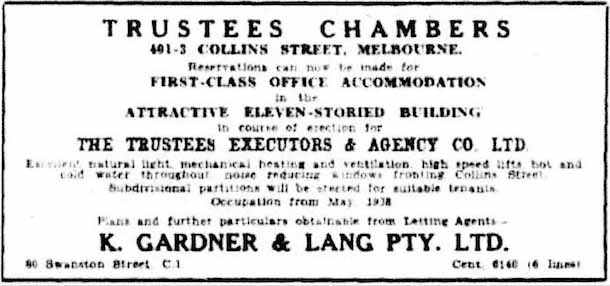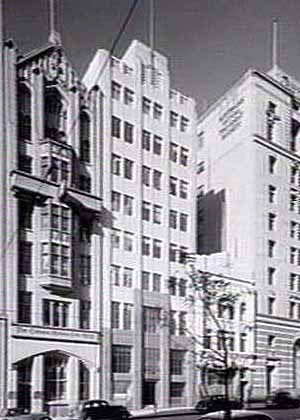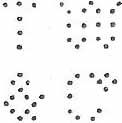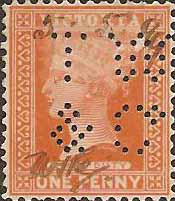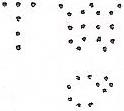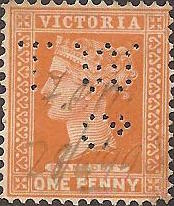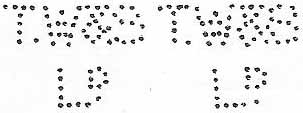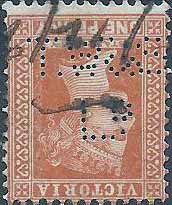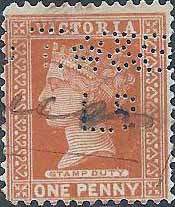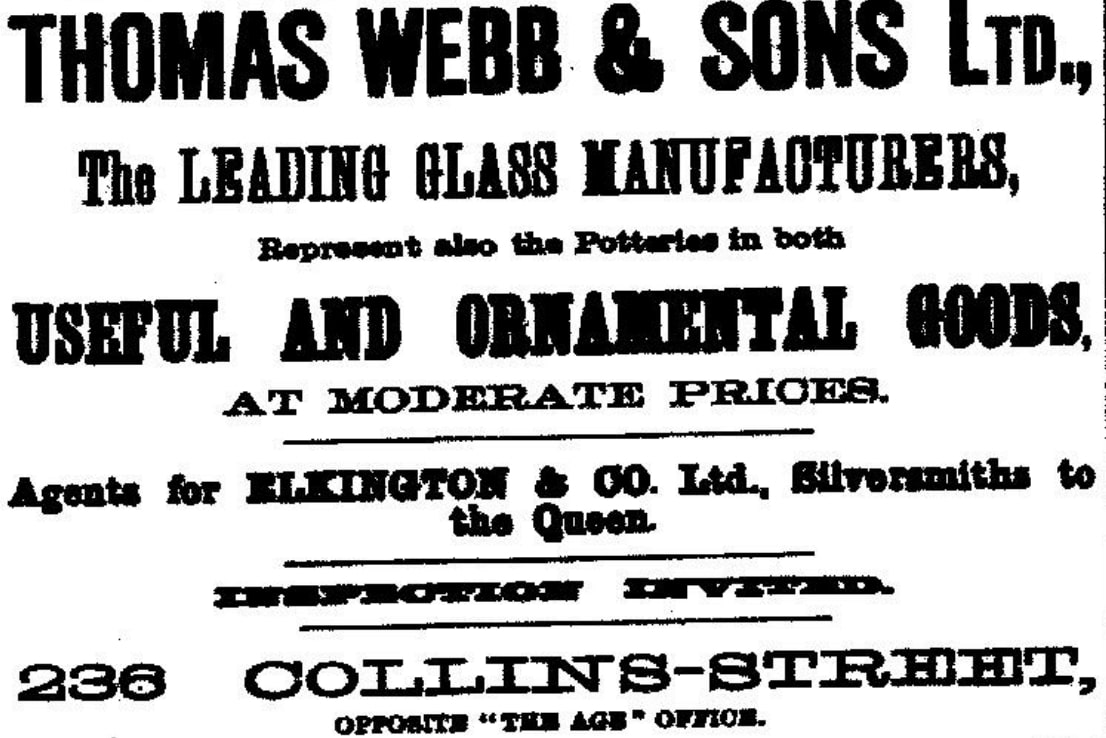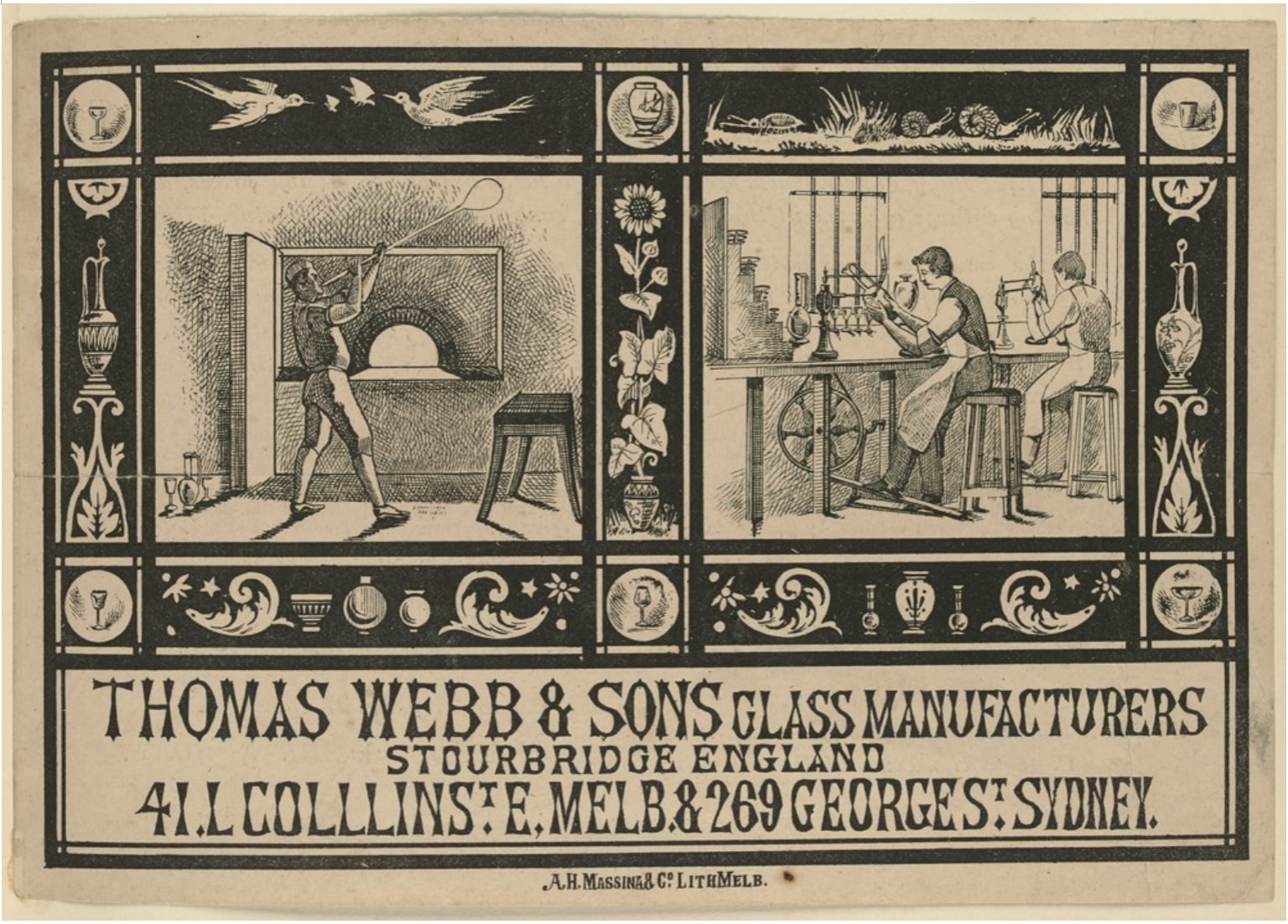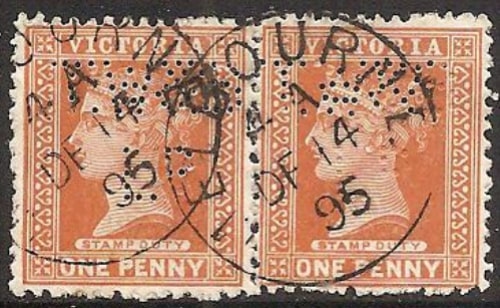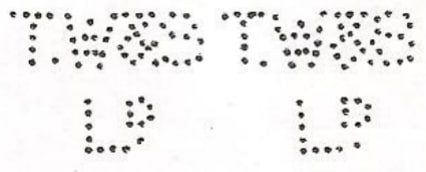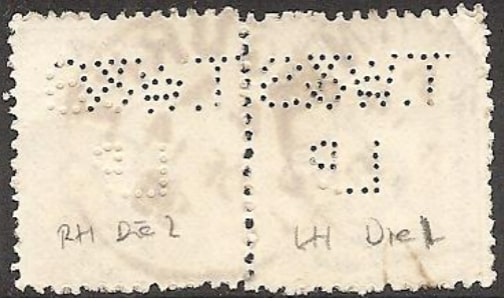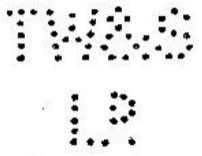|
Private Revenue Perfins of Victoria An Elsmore Coath production The authors would welcome your comments additions or input into this work A B C D E F G H I J K L M N O P Q R S T V W Y Other T -------------------------------------------------------- TC/&Co.a
User: Unknown Address: St, Melbourne, VIC Revenue Use: 1886-1899 Series, inscribed 'STAMP DUTY' 1d (shades) Rarity Scale:
1886-1899 Series 1d R4
Background: Unknown
Device: Device: The TC/&Co.a is one of just 2 TC&Co patterns that existed in around the period 1896 – 99, that were purchased for an unknown user by a Stamp Vendor making Temporary patterns in Melbourne.
All of these patterns are made from a temporary die in a single die format as made up by Stamp Vendors.
The TC/&Co.a pattern is rare on postage and even rarer on revenue stamps and its specific usage revenue stamps appears to be limited to 1896.
Related Patterns: Nil -------------------------------------------------------- TC/&S.a
User: Thomas Cook & Sons
Travel Agents and Tour Operators
Address: 269 Collins St, Melbourne, VIC
Background: *Thomas Cook was born in Derbyshire, England in 1808 and after a period as a gardener and apprentice cabinetmaker, in 1826 he became an evangelist and later in 1828 a Baptist Minister.
In 1832, Cook moved to Market Harborough in Leicestershire where he married Marianne Mason (1933) and their only son John Cook was born in January 1834. Thomas was very committed to the Temperance movement.
In 1841 he arranged for a group of 540 temperance campaigners to travel to a rally and in doing so arranged a discount fare with the rail operator and Cook was paid a share of the total fare. From 1844 Cook expanded these tours and this success led him to start his own business running rail excursions for pleasure.
He expanded into accommodation taking 350 people from the Midlands on a tour of Scotland however this resulted in his bankruptcy. However, he persisted and claimed to have arranged for over 165,000 people to attend the Great Exhibition in London in 1851. This lead to his first overseas tour to Calais (1855) to coincide with the Paris Exhibition. The following year he started his 'grand circular tours' of Europe and later in the 1860s he took parties to Switzerland, Italy, Egypt and the United States.
At this time Cook formed a partnership with his son John named Thomas Cook and Son, Travel Agents and they acquired premises on Fleet St, London. The company stopped personal tours and became an agent for foreign or domestic travel as well as selling travel accessories such as guidebooks, luggage, telescopes and footwear.
After a brief business expansion into the United States in the late 1860’s in 1872 Cook started to offer a round the world tours for just 200 guineas that included a steamship across the Atlantic, a stage coach across America, a paddle steamer to Japan and an overland journey across China and India, lasting 222 days.
In 1874, Thomas Cook introduced 'circular notes', a product that later became better known by American Express's brand as Travellers Cheques.
After some disagreements in the partnership Thomas retired in 1879 and returned to Leicestershire and lived quietly until his death in 1892. The company continued to grow under John’s management with his 3 sons, and this included expansion into military transport and postal services for Britain and Egypt. By 1888, the company had established offices around the world, including three in Australia and one in New Zealand.
John Cook died in 1899 after contracting dysentery while in Palestine. The company was taken over by his sons, Frank, Thomas (jnr) and Ernest however they were not very successful as their father and grandfathers and by 1928 the company was sold to a Compagnie Internationale des Wagons-Lits (International Sleeping-Car Company). After WWII the company was nationalised as part of the British Transport Commission. The company experienced difficulties in the early 1970’s and was rescued by a consortium of Banks before being broken up with the US operations being sold to Dun and Bradstreet in 1975. The company has prospered and has passed through many corporate hands as a result of mergers and takeovers and is still trading today as Thomas Cook Group Pl.
Device: The TC/&S.a is one of just 4 TC/&S patterns that are either confirmed or can be provisionally assigned to Thomas Cook & Sons.
All of these patterns are made from a temporary die in a single die format as made up by Stamp Vendors. These Temporary patterns date from 1896 until at least 1899.
The. TC/&S.a pattern is rare on postage stamps but even harder to find on revenue issues, with such usage limited to the period around 1897.
Related Patterns: Refer to other Thomas Cook & Sons patterns in: NSW: Other - Section 1 Cancelling Devices: Cook.a WA: Other – Section 1 Cancelling Devices: Cook.a * Wikipedia and “History of Leisure” by Rudy Koshar -------------------------------------------------------- T/M.a
User: Unknown Address: St, Melbourne, VIC Revenue Use: 1886-1899 Series, inscribed 'STAMP DUTY' 2d Rarity Scale:
1886-1899 Series 2d R4
Background: Unknown, possibly Thomas McPherson & Sons.
The company are known perfin users and purchased stamps with Temporary perfins from Stamp Vendors in the period from Circa 1905 until at least 1919 before purchasing a Customised perfin device, see M.
The company was called Thomas McPherson & Sons from 1860 but they used a range of letter combinations including, TMcP&S, TMcP and then simply M, so it is conceivable that they could use TM at some stage.
Device: The TM.a is one of just 2 similar patterns that date from around 1894-c1900 but have no confirmed user.
The TM.a pattern was made from a temporary die in a single die format as made up by Stamp Vendors.
It is rare on Postage stamps but even harder to find used as a Revenue.
Related Patterns: Unconfirmed possibly related to the TMcP group as well as some M’s of Thomas McPherson & Sons -------------------------------------------------------- TMcPa
User: Thos McPherson & Son Iron and Machinery Merchants Address: 554-566 Collins St, Warehouse (?) 582-592 Collins St, Showrooms Later (c1940) 546 Collins St, (Associated Machine Tools) Melbourne, VIC Revenue Use: 1911 Series 1d 1915 Series 2d, 6d Rarity Scale:
1911 Series 1d R4
1915 Series 2d R4, 6d R4
Background: See M.a
Device: The TMcP.a is one of approximately 9 patterns in the TMcP and TMP format that are either confirmed or provisionally assigned to Thomas McPherson & Sons, found used over the period c1905 - 1916.
The TMcP.a pattern is made from a temporary die in a single die format as made up by Stamp Vendors. This pattern was used between 1905 and 1915.
The pattern is fairly common on Postage stamps, but revenue use is quite rare.
Related Patterns: Refer to other McPhersons's and related company patterns in: VIC: M.a, M.b, M.e. -------------------------------------------------------- TO.a
User: Titles Office State Government Address: 247-283 Queen St, Melbourne, VIC Revenue Use: 1876 Statue Series 4d, 6d, 1/-, 2/6d, 5/-, 10/-, £1, £5 1884 Stamp Duty Series 10/-, £1 1886 Stamp Duty Series 25/-, £5 Rarity Scale:
1876 Statute Series 4d R4, 6d R4, 1/- R3, 2/6d R3, 5/- R4, 10/- R4 £1 R4, £5 R4
1884 Stamp Duty Series 10/- R4, £1 R4
1886 Stamp Duty Series 25/- R4, £5 R4
Background: *The “Office of Titles” came into existence following the Victorian Governments introduction of the Torrens System by the enactment of the Real Property Act 1862. The Torrens System (sometimes called Torrens Title) is a Land Registration and Land Transfer system devised by Sir Robert Torrens in South Australia, that lead to the first Real Property Act, which had been enacted in South Australia in 1858.
The Torrens System provides certainty of Title and tracks the sale of property and the subsequent transfer of that Title. The system has been adopted by many countries and has been adapted to cover other interests, including mortgages, leaseholds and other variations of Title.
The Act was first administered from a building near William St, but this was demolished to make way for the Law Courts complex. It was originally intended for the Titles Office to be located within the Law Courts, but it was soon realised there would be insufficient space so a site in Queens St was allocated.
The first part of the Queen St building was finished in 1877, at a cost of £30,772 and it consisted of the north wing along Little Lonsdale Street and some 115 feet along Queen Street. This included the north Strong Room. The South Strong Room was added in 1885 and the main building was extended in 1890 along the entire part block of Queens St from Little Lonsdale Street to Lonsdale Street.
The facade is regarded as a masterpiece of conservative Italian classicism and it was designed by a well-known Melbourne architect of the day, John James Clark.
In its day, the 247-283 Queen Street building was a physical representation of the solidity and strength of the Government’s commitment to the Torrens System and the security of the titles of Victoria's landowners, against misappropriation, theft and fire. The strong room with its stone walls, shuttered windows and doors of iron and floors of thick brick and cement, created a fortress.
In 2018 the Victorian Government completed the movement of the States 2.9 million Titles and related records to a new electronic system called, the Victorian Online Titles System (VOTS).
Device: The story of the TO.a pattern is something of a confusing one.
It was first reported in the Bulletin of the Perfin Club of New Zealand and Australia (PCNZA), the “South Pacific Perfin Bulletin” (SPPB) in Issue # 39 of October 1997 (report by John Amiet). Although no image of the stamp was given, it was reported as being found on a 25/- issue dated May 1905.
The Second report came in SPPB #54 of July 2001, again from John Amiet, with this 10/- above. This example is interesting because it has a cancelling cachet that confirms the "Office of Titles" (Titles Office) as the user. Further it shows a missing pin in the O at 4 o'clock and other examples of this period also show a missing pin at the base of the T.
Later, in about 2009 the examples at left were discovered and these show usage around 1924.
Interestingly, these examples also show a complete TO and it seems that the pins in these are thicker than the Circa 1877 examples.
This is a common feature of a repaired device in Private perfins.
In early 2020 another and much more substantial report of this pattern came from Russell Turner and Dave Elsmore, see: https://www.perfins.com.au/articles/TO.pdf
This report features a huge range of issues and strikes including impressive multiples that tell us much about the pattern and the device that made it.
The examples from this important report are all used on State Statute issues from the period 1876 to 1877 and interestingly the later usage shows an increasing number of missing pins.
The angles of the strikes are varied which tells us that the TO device was a single die device with a good reach.
It is uncertain at what point the stamps were struck so we do not know if the pattern was intended as a Security device (perfin applied prior to use) or as a Canceller (perfin applied at time of use). The Victorian Government used a range of cancellers in other Departments and these are listed in the “Other” Section of the Revenue Perfins of Victoria here:
https://www.perfins.com.au/OZ-Revenue-Perfins/Victoria-Revenue-Z-Perfins.html
However, the period of use of the othe Victorian Government cancellers such as the CLD cancelling devices, is not contemporary with the initial use of this TO device, so this practice may not be linked.
In summary the device came into service in about 1876 and was used for a short period of time and may have become unserviceable with missing pins.
Perhaps there was no use after 1877 and the Titles Office dispensed with perfins (or cancellers) until the TO device was repaired and had stronger and thicker pins inserted. This appears to have been done before 1905 but we cannot be sure, but a thicker pinned device was certainly in service in 1924, and perhaps beyond this time.
Related Patterns: Nil
*Victorian Government Web site “Perfin Stamps of Australia” Perfins.com.au SPPB Various issues -------------------------------------------------------- T.T./E.A..a
User: Trustees, Executor & Agency Co Address: 28 Queen St, Melbourne, VIC 401-403 Collins St, Melbourne, VIC Revenue Use: 1886-1899 Series, inscribed 'STAMP DUTY' 1d (shades) 1911 Series 1d, 3d 1915 Series 2d Rarity Scale:
1886-1899 Series 1d R4
1911 Series 1d R1, 3d R4
1915 Series 2d R3 Background: *The concept of Trustee companies had been growing in each of the States since the mid 1870’s and this lead to the passing of various State Legislation and the establishment of a small group of approved Trustee companies in each State. Such Trustee companies provided a range of financial management services, but principally they focused on estate planning, administering deceased estates, managing the financial affairs of persons unable to look after their own interests, and administering charitable trusts and foundations. Trustees, Executor & Agency Co (TEA, 1879-1983) was the first trustee company formed in Australia. TEA was established by William Templeton who had perceived a need for wealthy or moderately wealthy people to have a good executor to manage their affairs after their death. The company's formation required a special Act of Parliament, because such matters had previously only been handled by individuals.
The company was floated in 1879 with tight restrictions on the capital investments it could make and on how many shares any one person could control. Those shareholding limits and the legislated investment limits, had the effect of making the board and management very conservative.
In the 1970s the labour-intensive nature of the business was putting profits under pressure and TEA came up with the idea of offering other financial products as part of its client services.
These client deposits took off in a big way, growing to some $133m by 1982. However, many of these investments were moved from stable money market investments, into more risky property construction ventures.
It was not until 1983 that the Board became aware of the depth of the property ventures, at which point, it was almost too late to save the company from insolvency. Following failed attempts at a merger with Perpetual Trustees, TEA was wound up and its trustee operations were taken over by the ANZ Bank.
Device: The TTEA.a device was a customised device in a single die format. This has been proved by multiple strikes on postage stamps in which the strikes show no consistent relationship to each other.
The device was introduced in 1898 and remained in service until at least 1927 for use on postage stamps. Over this period of use the device generally produced clear and consistent patterns, so it is difficult to understand why it was discontinued. But, the device continued to be used on the companies revenue stamps up until at least 1955. This has also happened with other users and may be explained by the company moving to other secure postal options such as bulk mail or franking and leaving the perfin device for revenues.
Use on postage stamps is very common but use on revenue stamps is comparatively uncommon.
Related Patterns: Nil
* TROVE
-------------------------------------------------------- TW/&Co.a
User: Unknown Address: St, Melbourne, VIC Revenue Use: 1886-1899 Series, inscribed 'STAMP DUTY' 1d (shades) Rarity Scale:
1886-1899 Series 1d R4
Background: Unknown
Device: The TW/Co.a is an extremely rare pattern that is not listed in any other study of Australian private perfins. The usage of the only known examples is clustered around late June and early July in 1899 and it is possible that the pattern was intended to have an “&” and therefore would be another variation of a TW/&Co, similar to TW/&Co.a, but having a small & and Co. Such variation is within the scope of variation found with these Temporary patterns.
This pattern was made from a temporary die in a single die format as made up by Stamp Vendors.
The TW/Co.a pattern is extremely rare on both postage and revenue stamps.
Related Patterns: Most likely the same user as TW/&Co.a -- TW/&Co.b
User: Unknown Address: St, Melbourne, VIC Revenue Use: 1886-1899 Series, inscribed 'STAMP DUTY' 1d (shades) Rarity Scale:
1886-1899 Series 1d R4
Background: Unknown
Device: The TW/&Co.a is one of a total of 4 patterns that are all likely to have been used by the same company.
All of these patterns were made from a temporary die in a single die format as made up by Stamp Vendors. These group of Temporary patterns date from 1899 until at least 1900.
The TW/&Co.a is the most common variation of the TW/Co and TW/&Co group and there are 10 or so separate settings of the pattern, with the same basic structure and letter size, but different separation between letters and other variations such as misplaced pin locations, common on Temporary patterns.
The TW/&Co.a pattern is rare on both postage and revenue stamps but as is generally the case, it is much rarer on revenue stamps.
Related Patterns: Most likely the same user as TW/Co.a -------------------------------------------------------- T.W&S/LD..a & .b
User: Thomas Webb & Sons Ltd Glass manufacturers
Address: 41 Little Collins St, Melbourne, VIC Later from c1890 “Webb Building” 234 – 236 Collins St, Melbourne, Vic Revenue Use: 1886-1899 Series, inscribed 'STAMP DUTY' 1d (shades) Rarity Scale:
1886-1899 Series 1d R4
Background: *Thomas Webb & Sons Ltd, glass manufacturers, Stourbridge, England, sent a display and representatives, including John McCrea, to the Sydney and Melbourne Exhibitions of 1879 and 1880 respectively. Later they established branches of the company in both Melbourne and Sydney and McCrae was appointed Manager of the Melbourne office, which was initially at 41 Little Collins Street, but later (before July 1890) moved to a dedicated building, the “Webb Building” at 234-236 Collins Street.
Advertisement from the Illustrated Australian News July 1890. In about 1899 the parent company sold the Australian operations to a Mr J Riley who took McCrae into partnership and McCrea continued to manage the Melbourne operation. The company expanded its product range from glassware into tiles, china and related products. In 1930 the company was acquired by the Myer Emporium.
Trade Card for Thomas Webb & Sons, glass manufacturers, Stourbridge, England, 41 Little Collins St. E., Melbourne and 269 George St., Sydney Dated Circa 1885.
Device: This pattern was made by a customised device, that is one that makes a fixed pattern and cannot be changed to make other patterns, such as a device that makes Temporary patterns can. Customised devices are the most common form of perfin device in all States except Victoria, where Temporary devices are more common.
The layout of this pattern/device is interesting as it features a 2 die Horizontal array. This is most peculiar for a Victorian device of this period (1895-97) and we cannot recall another like it.
In previous studies the 2 dies have always considered to be a single pattern. This is understandable as the pins on the TWS&LD device are rather fine and can often produce an indistinct pattern and to be fair, the patterns are very similar. See below.
Looking at the style of the pattern and considering its 2 die layout, it seemed to us that it was most likely that the device was sourced in England. This led us to refer to the Great Britain Perfin Catalogue in which we found a similar pattern.
GB pattern T5190.01 (provisionally) Thomas Webb & Sons Ltd This GB pattern above is a very similar pattern and notably it is Provisionally attributed to Thomas Webb & Sons Ltd.
The 2 Die device in Victoria came into service in 1895 and was used until at least 1897. The pattern is scarce on postage stamps but very rare on revenues.
Related Patterns: Nil
*TROVE -------------------------------------------------------- A B C D E F G H I J K L M N O P Q R S T V W Y Other © copyright 2011 |
